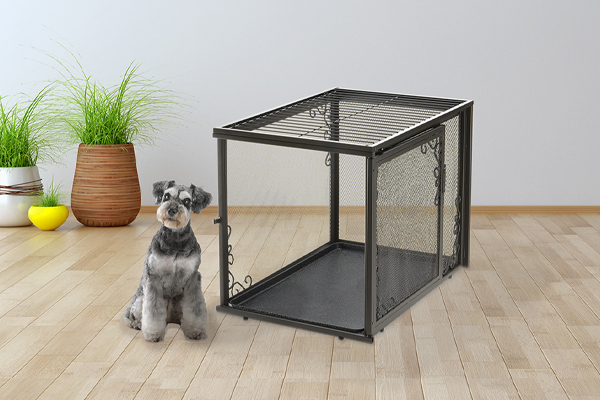
If this piece were instead titled “Why Crate Training isn’t Important”, it would be a much shorter read and one could immediately go about their day. However, it is a well-established fact that crate training is vitally important to both dog owners and dogs alike. The ability for canines to learn proper den behavior and become both crate trained and house trained is critical for the dog’s development and the owner’s sanity.
Crate training is the basis upon which a dog can fully participate in a family’s lifestyle. Until a newly acquired puppy, or yet to be house trained dog, completes “crate training 101”, it is open season on soiling anywhere in the house and possibly destroying furniture or items a family doesn’t want to be damaged. We all want our furry friends to eliminate outside and to not tear up the inside of our homes. Crate training is a critical piece of the obedience puzzle that each dog owner must solve – and as quickly and efficiently as possible.
A dog’s natural tendency is to seek a secure “den-like” haven to relax and sleep. By crate training your dog, you are assisting with the natural tendency of a dog to want a safe and cozy place to call their own. Not only will it help your canine companion, but it will help all involved in the care of the new addition to the family. By implementing the suggestions below, you will be able to crate train your new pet as quickly as possible so normal routines can once again be enjoyed.
Not a Prison
As dog owners, we can imagine a crate as a claustrophobia-inducing trap that we wouldn’t want to be subjected to. But dogs don’t naturally think about it as being “caged up” like we tend to view it. Instead, our canine companions enjoy the security, coziness, and “den-like” feel that a crate provides, especially if the crate is filled with comfortable furnishings that make it a highly desirable destination. Dogs like dens, dark cozy places, and an out of the way place where they can go to relax and be isolated from any loud or crazy happenings.
Expandable Pet Crate in Natural
Choosing the Right Crate and Size
It is crucial to choose the right crate size and type. If you want to only purchase one crate, a properly sized crate should comfortably house your puppy or new dog at the size they reach upon full maturity. This means it should be big enough for your pooch to lie down comfortably and be able to stand up and turn around when they are fully grown. Otherwise, you will need to buy different sized crates as your dog grows. The crate should also be cozy. It can either be a solidly constructed pen such as a kennel or travel crate, or a much more open wire crate that allows for plenty of air circulation. If you want the best of both worlds, a blanket, towel, or sheet can be draped over parts of the wire crate to create a more “den-like” environment when desired. Just be sure to leave enough openings for fresh air to circulate. One thing to remember when choosing one crate for the life of the dog - is that all the space is not needed when your dog is a puppy or a juvenile. That is where crate dividers come in handy. The right crate will be large enough to house your dog when fully grown, but include dividers to cordon off space not needed while your pooch is still a puppy. Dividers not only create a smaller, more intimate space but also provide only enough room to stand up, turn around, and lay down – and not enough space to do their “business”. This goes a long way in helping with “potty training”.
Introductions
Proper crate introduction is important so a puppy or new dog doesn’t become fearful of their crate. A crate should only be used positively and never as a place to punish a dog. Otherwise, the dog will begin to fear the crate and will no longer enter it freely. It is best to introduce puppies to a crate in a manner which only has them spending a few minutes in the crate at a time in the beginning. When they get used to the crate, they can then safely spend 3 or 4 hours in their crate before they need to be put out for exercise or a potty break. Be sure to crate your dog until such a time when they can be alone in the house without any accidents or destructive behavior. After that, they can graduate to a gated laundry or mudroom, bedroom, or another out of the way area when they need a safe and quiet place away from others.
The Right Vibe
A dog needs to feel comfortable in their new crate. When they are placed in the crate it should be during their quiet time when they want to relax. If they have just been playing and want to play some more, it’s not the best time to place them in their crate. Start by leaving them in the crate for ten or fifteen minutes, and then bring them back out. You can repeat this as often as necessary so they get used to the crate on their terms. The crate should be a relaxing, safe, and cozy environment.
Comfortable Settings
The crate should, above all else, be a comfortable setting for your pooch. Feel free to place a bed, towels, blanket, etc. in the crate if you feel your dog would enjoy these things. Some dogs are happy lying directly on the plastic flooring since it helps keep them cool if it is warm. Also, the bedding could promote going potty if your dog thinks it is material to be used to eliminate on. However, most of the time dogs will use these materials for comfort and not for soiling as long as the crate is not too big or the dividers are at the proper spacing. Another comforting item that can be placed in the crate is an old t-shirt with the dog owner’s or other family member’s scent on it. This can go a long way in making the crate feel more like home. A well-scented piece of clothing can also calm a puppy and help him relax and not whine.
No Bling
It is best practice to remove any collars, tags, leashes, bandanas, or similar devices before placing the dog in their crate. The last thing anyone wants is for a collar, tag, or piece of clothing to get caught on the crate and lead to a possible strangle situation.
Feeding in the Crate
By feeding near or in the crate, your furry friend will get used to their crate more easily and be increasingly accepting of being near or in it. When feeding inside the crate, it helps to put the food bowl inside the crate just a little. Let the eating commence, then move the bowl further back in the crate. Do this again until the food bowl is at the end of the crate or divider and then shut the door as your dog continues eating.
Treats are also good to give when they have freely entered their crate. It’s a great way to make them instantly feel more comfortable with their new space. A Kong bone or similar can be filled with peanut butter, bread, soft tortilla pieces, etc. and can keep your pooch occupied for hours trying to remove the treats. If peanut butter is used and can be frozen in the toy ahead of time, it will last even longer and provide an extended stay in the crate without fuss.
Crate Fun
Games can be played that are centered around the crate. Play fetch with a ball and throw it in the crate. What better way to introduce Fido to their new surroundings. Treats can also be hidden inside the crate for even more crate fun.
Increasing Time in the Crate When at Home
When your dog can be left for about 30 minutes in their crate without becoming over-anxious or afraid, then you can begin leaving them in their crate for longer periods. Encourage them to go into their crate with your normal command and be sure to include a treat. Adding a bone or toys will help keep your pooch occupied while they are in their crate.
Crating While Away and at Night
When it’s time to leave your dog in their crate as you go to work or out to run some errands, don’t get emotional when you leave. Say a simple, matter of fact goodbye and venture out the door. The more prolonged the goodbye, the harder it will be for them to remain calm. When you return, keep your arrival monotone and low key as to not make your pup anxious about your arrival then or for future arrivals. Act like you expect them to be comfortable and at peace in their crate and they will follow your lead.
When crating at night, it is helpful to again include a piece of clothing such as a t-shirt that has a familiar scent associated with it. That will bring a great deal of comfort to your dog. Also, if it’s possible to place their crate close to your bedroom they will feel more secure and you will be able to more easily hear them if they stir in the middle of the night and have to take a restroom break. It can at first be a challenge determining if any whining or barking at night is due to your pooch needing to go to the bathroom or him just testing you because he’s lonely and wants to be with you. If you feel he needs to go to the restroom, be calm, say let’s “go potty” or another phrase you may have already used, let him outside to see if he needs to go and when finished lead him right back to his crate and say goodnight. Any whining after that can be ignored for the remainder of the night or at least 3 or 4 hours.
Crate training isn’t easy, but it is essential for the well being of the dog and its owner or family. Not only does it train your new puppy or dog to self-soothe successfully, but it also provides a safe “den” environment away from any hazards. In addition, it aids tremendously in potty training efforts. It can be hard work, but it will pay big dividends in the long run if you stick with it.
The Mobile Pet Pen 940 has made owning and training my puppy so much easier! With this pet pen I am able to efficiently put in and take out my puppy whenever I choose, while keeping him safe while he is in it. The pen has fantastic accessibility through either a spring loaded latching side door, or the two second removal of its top. Its perfectly sized and smooth rolling caster wheels make maneuvering the pen from room to room a breeze. With its glossy, non-porous and very easy to clean tray, and attractive black wire enclosure with accented rich wood, this pet pen is very functional, yet supremely stylish. It is a comfortable size, and I can easily place my puppies bed in without any problems. The expert craftsmanship, engineering and attention to detail is amazing! I am extremely pleased with this product, and I would highly recommend it to anyone who is looking for a sturdy, expertly designed, well built and beautiful mobile pen for their pet.
Thank you Richell for making pet products that not only function at extremely high levels, but that also look fantastic while doing so."
Ashleigh, TX
 How to Keep Your Cat Happy & Healthy
How to Keep Your Cat Happy & Healthy
09.14.2020
As we head into September and begin winding down summer activities in lieu of cooler fall adventures, it’s the perfect time of year to start spending more time with our feline companions. And as it just so happens, ... >>> READ MORE
 The Importance of Regular Vet Visits for Your Cat
The Importance of Regular Vet Visits for Your Cat
08.27.2020
Approximately 67% of U.S. households owned a pet in 2019 according to The American Pet Products Association (APPA), and out of all those pets, one third were cats. >>> READ MORE
 10 Dog Walking Tips for an Enjoyable Outing
10 Dog Walking Tips for an Enjoyable Outing
07.27.2020
A walk in the park, a stroll around town, or a tour through the neighborhood should be a pleasant experience for both a dog owner and man’s best friend. >>> READ MORE
Please complete this form and click "Submit". Our Customer Support team will gladly address your request and respond in a timely manner.
Richell USA, Inc.
Copyright © Richell, Inc.. All rights reserved